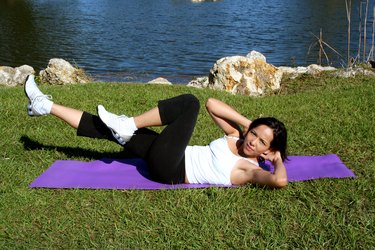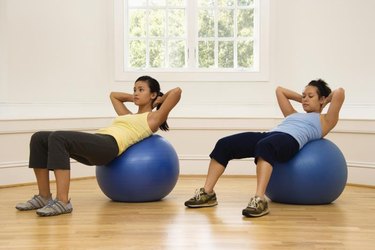
If you've ever done bicycle crunches, you know firsthand they target all your ab muscles. In fact, the American Council on Exercise declared bicycle crunches one of the most effective abdominal exercises, according to a small study performed in 2001.
The move activates muscles of the abdomen better than 12 other exercises, including the traditional crunch, a crunch with your legs up in the air and several ab workout "machines." While no one abdominal exercise comprehensively addresses all the muscles of the abdomen, the bicycle crunch comes close.
Video of the Day
Video of the Day
Primary Target: Abdominal Muscles
The bicycle crunch lifts the torso and contracts the abdominal muscles in the same way as a standard crunch. Thus, the rectus abdominis — the front sheath of your abs that make up the "six-pack" muscles — are activated. This muscle has an upper and lower region, both of which come into play, especially during the twisting portion of the bicycle crunch move.
Your external obliques, the muscles at the sides of your waist, are also activated as you rotate your body to bring a shoulder to the opposite knee. These muscles turn your torso side to side and help you bend sideways at the waist. Strong obliques also contribute to a stable, well-aligned spine.
Tip
Do a bicycle crunch correctly: Lie on your back and lift your knees up to form a 90-degree angle at your hip and knee joints. Cradle the back of your head and upper neck with your hands.
Lift your right shoulder toward your left knee. Simultaneously extend the right leg. Repeat on the opposite side. Move slowly and methodically to get the most muscle activation out of the exercise.
Quadriceps: Hip Activation
The rectus femoris, located in the middle of the upper thigh, is one of the four quadriceps muscles. It assists in extension of the knee and hip as you "pedal" during the move.
The standard crunch doesn't provide much activation for this muscle, but it is well-utilized in the bicycle crunch. This muscle crosses the hip joint, so the bicycle crunch could aggravate tight hip flexors in some people.
Intercostals: A Breathing Muscle
Between the ribs are muscles known as the intercostals. They help form the chest wall and rotate the torso during the bicycle crunch. They also help elevate and depress the ribs.
Work these muscles to help develop better breathing capability, which enables you to take more oxygen to send to working muscles with every breath. You may not see a visible "six-pack" from working the intercostals, but you will feel it when breathing heavily as you lift heavy weights or sprint uphill.

Don't Stop with Bicycle Crunches
No one abdominal exercise comprehensively works all the muscles of your core. Augment bicycle crunches with additional moves to achieve a balanced core.
For example, use the plank to engage the deep, internal transverse abdominis, which is essential to posture and core stabilization.
Add an exercise that focuses on the supporting muscles of the back, as well, to develop a balanced, functional trunk. Do bird dogs by getting into a kneeling table-top position. Extend the right arm and the left leg so that they're parallel to the floor.
Hold for a full inhale and exhale, then repeat on the other side. This move works the erector spinae, the muscles along the spine, along with the middle and upper back and the gluteus maximus. Crunches on a stability ball are another key move to include in your core-training repertoire.
Read more: 21 Sit-Up Variations You Won't Totally Hate